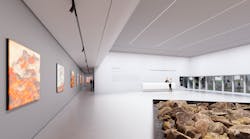Many factors can influence someone to purchase a work of art: a personal connection to the artist, trust in a gallery’s recommendation, a lasting first impression—or perhaps all these factors. But one thing is clear: The art market relies on direct encounters with artwork. Amplifying these interactions with light and architecture is critical.
Leveraging your gallery layout with lighting
Gallery lighting can encourage the sale of art in several ways. Good lighting enhances the visual appearance of art. Works can become more vivid and attractive and even impart a magical quality. Lighting can also help gallery owners increase the public’s accessibility to art and artists by drawing in interested parties and potential patrons to their spaces.
In this article, ERCO offers best practices for five approaches to gallery lighting based on architectural design and desired effect.
1. White cube
A white cube gallery, in which artworks are displayed in a straightforward, objective manner, needs only vertical ambient lighting. Atmospheric wall washing enhances the feeling of space and height, emphasizing architectural features and offers a clear sense of orientation for visitors.
In this scenario, lighting designers should specify luminaires with a reflector lens system for illuminating the gallery space via reflection from the walls to achieve uniform wall washing. This homogeneous lighting approach complements architecture and works of art equally, and is thus suitable for large-format artworks, group exhibitions, competition exhibitions, sculptures, and abstract art.
2. Minimal accentuation
This combination of wall washing and accenting subtly sets artworks apart from their illuminated surroundings. Directional light emphasizes the key works in a gallery, directing the viewer gaze to guide them through the exhibition. Lighting designers can further enhance nuances by creating visual contrasts, such as varying wall washing and spotlighting color temperatures or modifying brightness ratios between 5:1 and 10:1. Larger differences create more contrast.
Minimal accentuation is particularly effective with sculptural artworks because it can showcase the molding of structured surfaces. Spotlighting from different directions can support the rendering of surfaces and reduce undesirable shadowing.
3. Dramatic accentuation
As its name suggests, dramatic accent lighting provides a sense of drama in galleries or museums. This lighting strategy is well suited to dramatic architectural spaces as well as areas without natural light, such as subterranean galleries in bunkers and passages.
In this case, exhibition designers use accent lighting to create intense contrasts of brightness between artwork and its environment, turning light and shadow into design tools. Rich contrast, bright-to-dark displays with targeted accent lighting by spotlights can bring an artwork or installation to the fore and capture the viewer’s attention.
Dark wall colors with low reflection can increase the contrast up to a brightness ratio of 50:1. Gallery owners can use shadows generated by accentuated sculpture to evoke emotion.
4. Black cube and hyperreal
The exaggerated sense of reality in a black cube gallery stands in stark contrast to the white cube. In this scenario, black-painted walls recede behind the works of art, which are precisely accentuated by contour-framing. The resulting effect is suited for photographic works, artwork requiring conservation, and artwork with cinematographic references or spiritual topics that rely on the emphasis of color and detail.
When the contour framing appearance is precisely adjusted to the rectilinear edges of an artwork, lighting designers can create a self-luminous light box. When combined with RGBW color-changing luminaires, contour framing can create a 3D effect for artworks with hyperreal themes. Precise contour framing offers low illuminance levels and control of spill light, allowing the contrasting illuminance levels to emphasize the artwork details.
5. Immersive gallery
In immersive galleries, the entire space is enveloped in color. Wall-washing optics and RGBW LEDs in recessed downlights or spotlights bathe the walls in color, visually highlighting artworks with warm or cool color temperature accents and contrast. Color immersion can bring together different art forms, such as mixing light art, videos, and light boxes with paintings, photographs, and sculptures.
Systems operating on Bluetooth lighting controls can offer more than 16 million colors and adjustable brightness levels. The flexibility of RGBW allows reverting back to typical 3000K to 4000K color temperatures as needed.
Attain the perfect angle
Each gallery type described above offers a unique way of presenting art and using light as a scenographic design tool. Accent lighting is the key to making art stand apart from their surroundings. Luminaire alignment and the angle of incidence of light—also known as the “museum angle”—are critical to the staging of art and the visual comfort for visitors.
The ideal luminaire arrangement for art galleries is perfectly aligned accent lighting in the “museum angle.” For wall art, this angle is 30 degrees. A steeper angle of incidence can lead to distracting grazing light. An angle of incidence that is greater can result in viewers casting shadows on the art.
Ideal situation
When the angle of incidence is 30 degrees, a luminaire casts uniform brightness on the art surface and reveals textures from strong brushwork or reliefs. This angle also prevents glare for observers caused by reflections on art behind glass.
Steep angle of incidence
An angle of incidence significantly less than 30° causes extreme shadowing on exhibits. Textures caused by brushstrokes or reliefs appear exaggerated and shadowing from frames is possible. Despite the illuminance level, only a low impression of brightness is created on the picture surface.
Wide angle of incidence
An angle of incidence distinctly more than 30 degrees can result in observers casting shadows on artwork and reflected glare on glass-protected or shiny works. Artwork texture and reliefs will appear flat.















